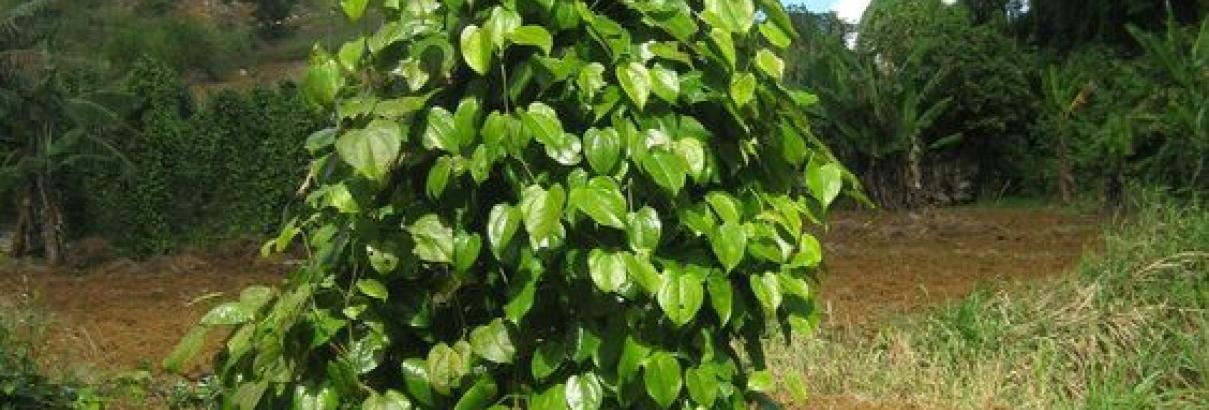Yams (Dioscorea spp., Dioscoreaceae) are important staple crops for food security grown for their starchy tubers in many countries in West Africa, Pacific, Caribbean and Highlands Asia. Yams are also indigenous crops tied up with the cultures and traditions of the people in the Pacific Islands and in the so-called yam belt which stretches from Côte d’Ivoire to western Cameroon. They are subject to ceremonies, are given as dowry and are used in many culinary preparations and for their medicinal properties.
The genus comprises c. 640 species with the main cultivated edible species being notably D. cayenensis Lam. and D. rotundata Poir. that originated in West Africa, D. nummularia Lam., D. oppositifolia L., D. transversa R.Br. from Southeast Asia and Oceania; and D. alata L. from mainland Southeast Asia. Many other species have a local importance either for food security or for medicinal uses. Indeed, some species are used mainly in traditional medicine and are part of indigenous knowledge in Africa, Asia, such as in India, and in Oceania. While others are the focus of pharmaceutical industry, used for diosgenin and other steroids to synthesize derivatives such as corticosteroids and sex hormones.
Yams produce botanical seeds and are vegetatively propagated in the farming systems. The crop domestication led to decrease in flowering capacity. In addition, many species are polyploids, with even in some such as D. alata the presence of mix of ploidy. Such biological features should have threatened the diversity along the time. However, in traditional agrosystems, small-scale farmers continue to grow large diversity of varieties fulfilling their consumption needs.
In situ / on farm challenges
Few works have fully documented the on farm diversity. The most well documented ones were conducted in Benin1 2 3 and more recently in Papua New Guinea, or at regional and worldwide level4 5 6 7 . Even though the yam species grown in these countries are different, many common features were observed. These countries hold an important diversity managed by farmers. These latter introduce wild yams from sympatric bushes or forests in their cultivated compartments. Hybridisation between wild and cultivated yams are common, which is responsible of introgression of favourable alleles in the cultivated ones. However, the wild yams diversity in situ has been scarcely documented even though along the time they have proven their importance in maintaining the diversity. Consequently, it will probably fall to the wild pool to respond to the new conditions where traditional varieties are not adapted.
In a context of changing environment, an increasing urban demand and anthropogenic pressure, it is of upmost importance to conduct a comprehensive and multi-disciplinary documentation of the on-farm and in situ diversity in yam hotspots area, and the farmers' knowledge associated with. These practices have been contributing to broadening the yam varietal portfolio in order to respond to different uses, to shield against risk, and to respond to environmental constraints. Such work will enable the implementation of comprehensive strategy of conservation and an access to well documented diversity for breeders and users along the chain-value.
Additional information related to Guinea Yams in Benin Republic: Wild Yams Contributing to Domestication Process
- 1Dansi A, Mignouna HD, Zoundjihekpon J, Sangare A, Asiedu R, Quin FM (1999) Morphological diversity, cultivar groups and possible descent in the cultivated yams (Dioscorea cayenensis/D-rotundata) complex in Benin Republic. Genetic Resources and Crop Evolution 46(4):371–388. https://doi.org/10.1023/a:1008698123887
- 2Scarcelli N, Tostain S, Mariac C, Agbangla C, Da O, Berthaud J, Pham JL (2006) Genetic nature of yams (Dioscorea sp.) domesticated by farmers in Benin (West Africa). Genetic Resources and Crop Evolution 53(1):121–130. https://doi.org/10.1007/s10722-004-1950-5
- 3Chaïr H, Cornet D, Deu M, Baco MN, Agbangla A, Duval MF, Noyer JL (2010) Impact of farmer selection on yam genetic diversity. Conservation Genetics 11(6):2255–2265. https://doi.org/10.1007/s10592-010-0110-z
- 4Obidiegwu J, Loureiro J, Ene-Obong E, Rodriguez E, Kolesnikova-Allen M, Santos C, Muoneke C, Asiedu R (2009) Ploidy level studies on the Dioscorea cayenensis/Dioscorea rotundata complex core set. Euphytica 169(3):319–326. https://doi.org/10.1007/s10681-009-9960-1
- 5Scarcelli N, Cubry P, Akakpo R, Thuillet A-C, Obidiegwu J, Baco MN, Otoo E, Sonké B, Dansi A, Djedatin G, Mariac C, Couderc M, Causse S, Alix K, Chaïr H, François O, Vigouroux Y (2019) Yam genomics supports West Africa as a major cradle of crop domestication. Science Advances 5(5):eaaw1947. https://doi.org/10.1126/sciadv.aaw1947
- 6Sharif BM, Burgarella C, Cormier F, Mournet P, Causse S, Van KN, Kaoh J, Rajaonah MT, Lakshan SR, Waki J, Bhattacharjee R, Badara G, Pachakkil B, Arnau G, Chaïr H (2020) Genome-wide genotyping elucidates the geographical diversification and dispersal of the polyploid and clonally propagated yam (Dioscorea alata). Annals of Botany 126(6):1029–1038. https://doi.org/10.1093/aob/mcaa122
- 7Sugihara Y, Darkwa K, Yaegashi H, Natsume S, Shimizu M, Abe A, Hirabuchi A, Ito K, Oikawa K, Tamiru-Oli M, Ohta A, Matsumoto R, Agre P, Koeyer DD, Pachakkil B, Yamanaka S, Muranaka S, Takagi H, White B, Asiedu R, Innan H, Asfaw A, Adebola P, Terauchi R (2020) Genome analyses reveal the hybrid origin of the staple crop white Guinea yam (Dioscorea rotundata). PNAS 117(50):31987–31992. https://doi.org/10.1073/pnas.2015830117





